The most common reasons your b2b aviation customers give you a one-star review on Facebook, Google or Yelp may not have anything to do with you.
[smart_track_player url=”http://traffic.libsyn.com/aviationmarketing/Five_Reasons_for_Bad_Reviews_-_Podcast.mp3″ background=”default” ]
Paula Williams: Welcome to this week’s episode. I’m Paula Williams.
John Williams: I’m John Williams.
Paula Williams: And we are ABCI and ABCI’s mission is?
John Williams: To help a little you ladies and gentlemen out there in the aviation world sell more products and services.
Paula Williams: Absolutely. And-
John Williams: And help you with your reviews.
Bad Online Reviews Can Hurt You!
Paula Williams: Right, exactly. This is the second in a three part series on defense against the dark arts or reputation management, which is something that is becoming much more important over the last year or so for all of our clients who are discovering that these review sites are not all fun and games and they actually do impact their business.
 So that is what we’re talking about today. This episode is brought to you by, conveniently?
So that is what we’re talking about today. This episode is brought to you by, conveniently?
John Williams: Our new product.
Paula Williams: Our new product, which is our Aviation Reputation Management Product. Which is a combination of software and service where we assist you to set up a system to watch for reviews, and manage them, and respond to them proactively, and get more good reviews and fewer bad ones, and make sure that the bad wounds impact you as little as possible. Right?
John Williams: Exactly.
Paula Williams: Okay. So last week we talked about defense against the dark arts and Harry Potter. I’m a big fan. This is one of the reasons that my son really got into reading was a million years ago we started reading the Harry Potter books.
And as in the last episode, one of the discussions going on between the teachers at Hogwarts, which was a school for young wizards is, should we teach defense against the dark arts to these kids or should we just let them never know that there is evil in the world? Right?
John Williams: And let them experience it on their own.
The Five Most Likely Scenarios for Bad Online Reviews
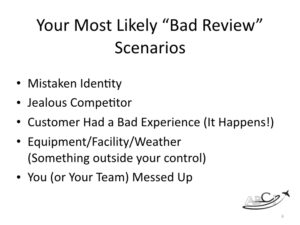 Paula Williams: Right. That’s a great idea. So in the same spirit, we are talking about reviews, and how to manage them, how to defend yourself against a bad one, and how to get more good ones. So that’s the purpose for this series.
Paula Williams: Right. That’s a great idea. So in the same spirit, we are talking about reviews, and how to manage them, how to defend yourself against a bad one, and how to get more good ones. So that’s the purpose for this series.
So in this episode we’re going to talk about your five most likely bad review scenarios. And this might be a little bit different depending on whether you’re at charter company or a flight school or a maintenance and repair shop, part 145.
Whatever your part of the aviation industry is you want to make sure that you are on top of these five and possibly some others that are specific to you.
Okay. So number one, mistaken identity. Number two, jealous competitor. Number three, customer had a bad experience. Number four, equipment facility. Weather, something out of your control. Five, you or your team messed up. It is possible.
John Williams: Oh, say it isn’t so.
Paula Williams: Right. Even in aviation it sometimes happens. Okay, so the simplest of these is the mistaken identity, right? And it happens a lot in aviation because a lot of us have very similar names. A lot of companies have very similar names.
Mistaken Identity
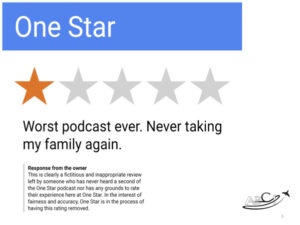 We’ve been mistaken for another marketing company before, they’ve been mistaken for us. There’s a lot of things that can happen and sometimes it’s completely off topic. So this is a podcast that got a one star review. “Worst podcast ever, never taking my family again.”
We’ve been mistaken for another marketing company before, they’ve been mistaken for us. There’s a lot of things that can happen and sometimes it’s completely off topic. So this is a podcast that got a one star review. “Worst podcast ever, never taking my family again.”
Clearly they thought it was a movie or something. And it is clearly irrelevant and obnoxious. So what do you do when one of these happens to you?
John Williams: What do you do?
Paula Williams: Well, we have a process and we’re going to use this five times for these five different types of reviews.
John Williams: This is why I asked you because I didn’t want to have to go through this.
Paula Williams: Oh, well you want me to do it?
John Williams: Yes.
Paula Williams: You want me to do all the talking?
John Williams: Of course.
Be Prepared with a Process for Managing Reviews
 Paula Williams: Okay. So being prepared for a bad review often means having a good process that your people can follow. Especially if you have someone else doing your social media. Someone on your staff or someone like ABCI.
Paula Williams: Okay. So being prepared for a bad review often means having a good process that your people can follow. Especially if you have someone else doing your social media. Someone on your staff or someone like ABCI.
We want to make sure that we have a good process so that we know what things need to be escalated, what things we should handle, and how we want to make that work.
So the first thing, is it positive or negative. If it is negative, evaluate the purpose. So obviously this person is, I’m guessing a want to be comedian, right? And next question is, are the facts correct? No, they are not correct.
So then you want to gently correct the facts. And this is something that is a little bit different than the way that they handled it. I think I would do this a little bit more gently to the person because you’re not just responding to that person, you are responding to everybody on the internet potentially.
John Williams: That’s correct.
Don’t Feed the Trolls!
Paula Williams: Right? So you want to be seen as the adult in the room. Just like, “I’m sorry, I think there’s been some mistake. I’m not sure how you would take your family to this podcast, but we’re in the process of having this review evaluated because we think it’s inappropriate.”
So I think they could have been a little kinder in their response and you never lose by being more courteous than the other person. And I think that’s a-
John Williams: And you never win by being-
Paula Williams: By losing face, right?
John Williams: That’s right.
Paula Williams: Or you lose face when you lose your composure. So you want to make sure that you are the one who’s in control of the situation. You never want to feed the trolls by reacting in a way that shows you’re angry or upset.
And don’t get me wrong, bad reviews can be upsetting. Especially if they are unfair or inaccurate or if they’re going to impact your business and you feel helpless. In some cases it’s real easy to just pop off with something smart or something searingly, blisteringly horrendous. But you don’t want to do that. The cost of that is just-
John Williams: But you may want to do that, but you better not do that.
Paula Williams: Exactly. So let it sit, have a third party handle it. Whatever you need to do to remove yourself from the situation and don’t let them get under your skin because they’re trolls, right? You don’t want to feed the trolls that just makes more of them. Right? Like, putting water on a Gizmo. That movie with the Furbies?
John Williams: Oh, yeah.
A Jealous Competitor
Paula Williams: Anyway, yeah. Okay. So let’s talk about the second scenario. Let’s say we have a jealous competitor that is creating fake accounts and writing bad reviews. This is also happened with a client recently.
So you have a competitor that’s jealous, they can go online, they can create an account, they can leave a bad review. And they can just run right and never use that account again. Now most of the review sites, and Google is probably the most explicit of them with their terms of service and everything else.
Everybody else is kind of following Google, to be honest. So if you want to learn one set of terms of service it probably should be Google’s. So what are the guidelines for Google content for someone posting on Google? And that’s going to be pretty similar across the board for the other review sites.
Okay, so these are the things that are not allowed on Google. And if the review that your fake competitor left falls into any of these categories, you can contest it and have it removed.
Dispute Fake or Invalid Reviews
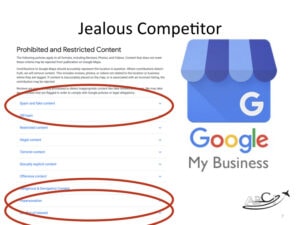 So, spam and fake content. That’s thing number one on this list. So if you believe that this person doesn’t exist, this is not a customer of yours, then you write Google. You tell them, “This is not a customer of ours. They said that they were, they said they had a bad experience. We don’t have any record of ever having served this person.”
So, spam and fake content. That’s thing number one on this list. So if you believe that this person doesn’t exist, this is not a customer of yours, then you write Google. You tell them, “This is not a customer of ours. They said that they were, they said they had a bad experience. We don’t have any record of ever having served this person.”
Whatever the situation is. You tell Google that, you don’t tell the person directly.
John Williams: Exactly.
Paula Williams: Okay? So you follow the review process, you click the button, you do the things. We’re not going to tell you exactly what buttons to push or anything like that because it’s different for every review site and they’re going to change it next week anyway.
But you follow the process and you make sure that you can test that review out of the public eye. Right?
John Williams: True. Yes.
Paula Williams: Okay. Another thing that sometimes happens is impersonation. So if someone is impersonating someone else, especially a jealous competitor is impersonating someone who may have been a customer of yours or a famous aviation figure leaving a bad review … So if you get a review from Buzz Aldrin or something like that, saying that your company sucks, this is the one that you would use for that.
Because I think he’s actually a really nice guy and I don’t think he would do that. And the last one is conflict of interest. If it is a competitor leaving a bad review and you can show that. So those are some things that you can do to make sure that those get removed.
What you can’t get removed is if it is honest and if it is maybe even an honest mistake. Somebody had a bad experience, whatever, you can’t get it removed. Google, Facebook, all of those sites have a lot invested in credibility and they’re getting attacked a lot on their credibility.
So they’re going to want to make sure that they’re following their own rules. So that’s how you address that.
John Williams: <<Sneezes>> Excuse me. Yup.
Customer Had a Bad Experience
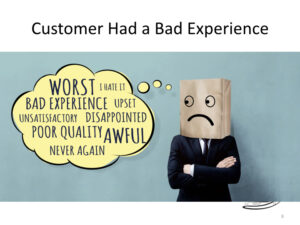 Paula Williams: Bless you. Okay. Cool. All right. Next, most likely a customer had a bad experience. Now this sometimes happens in spite of our best intentions and efforts and everything else.
Paula Williams: Bless you. Okay. Cool. All right. Next, most likely a customer had a bad experience. Now this sometimes happens in spite of our best intentions and efforts and everything else.
There was a time when I was in high school and college when I worked as a waitress waiting tables. And it seemed like there was always that one table that no matter what you did, everything went wrong. We were out of this, and this got cold, and they didn’t like that, and they had an allergy to this.
I mean, for any reasons, some of which were under our control, some of which were not, everything went wrong with that customer and it seemed like the worse it got the worse it got. Right?
John Williams: Of course.
Paula Williams: Okay. So once again, you want to follow the process. Is this a negative review? Obviously. Are the facts correct? Probably. What is the best thing that you can say to this person? I’m really sorry that you had a bad experience, and we would really like to make it up to you, and we’d really like to have you see us at our best instead of at our worst. So we’re sending you a gift certificate.” Or something like that so that they can try you again.
And you can do that in public. You want to be as kind and courteous and timely as possible and not just let that sit because you don’t want to talk to that person ever again and you want to hide under the bed. That doesn’t work, you have to address it. And you really need to do that as adult-ly-
John Williams: And even if you haven’t done it in the past, you can start any time.
Paula Williams: Exactly. So let’s say you just found out about a review of someone that had an awful experience in 2015 and you didn’t know about it. Say so. And in some cases there are so many review sites. There’s Glassdoor, and Yelp, and Google Your Business, and Facebook.
And if you weren’t on social media, you may not know about a bad review. So you find out about it three years later, you want to reach out to that person if you can and say … Even if you weren’t even there at the time.
You’ve taken over the company or whatever, you want to make sure that you reach out to those folks and leave a review and say, “Please give me a call. I’d love to talk to you about this and let’s see what we can do to make it right.”
Be Articulate, Thoughtful and Kind
John Williams: And when you write whatever you write from the corporate perspective, make sure you’re articulate, thoughtful-
Paula Williams: And kind.
John Williams: … and kind.
Paula Williams: Yes, exactly. No matter what you want to be, make sure that you are-
John Williams: And I can tell you from personal experience that it works.
Paula Williams: Yeah.
John Williams: Because-
Paula Williams: Do tell.
A Complaint is a Second Chance to Get It Right
John Williams: Well, I’ve had an issue with an unnamed company, which is national at least in scope and couldn’t get any of the local people to help. So I wrote corporate.
Paula Williams: A very good letter I might add. I proofread it for him so I know who he’s talking about.
John Williams: And believe it or not, I got a call from corporate, a phone call, and they explained to me that this is not a corporate issue and they were going to have people working on it until it’s resolved. And furthermore, my place to call for the next 30 business days is this person from corporate.
Paula Williams: Who was going to be handling it personally.
John Williams: Yes.
Paula Williams: Right.
John Williams: Wow. And they had people come out here and they took care of the things they were supposed to take care of and waited around for a couple hours to make sure it worked. And then they left and it’s working to this day. So I’ve still got 20 or 30 days left. I don’t know.
Paula Williams: Exactly. So as you can guess, this is kind of a utility company. So it’s something that we’ve been dealing with, and dealing with, and dealing with, and were really, really upset and frustrated. But we didn’t let that upset and frustration come out-
John Williams: In the letter.
Paula Williams: … in the letter. It was all very, very factual. And in their response to John was very, very factual, and very practical, and very helpful, and very kind. So we have a different experience about that company now and we might tell you more about that later.
John Williams: Yeah, maybe.
Paula Williams: Maybe. Depending on how it goes. Okay. So yeah, a customer has a bad experience. It happens. Just deal with it as objectively and kindly as you possibly can.
John Williams: Yes.
Equipment, Weather, And Other Circumstances
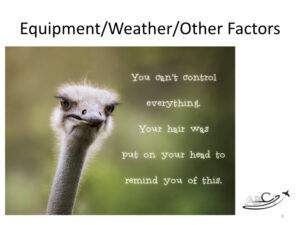 Paula Williams: Okay. Equipment, weather, and other factors. And if you’re just listening to this, this is the picture of an ostrich with crazy hair and it says, “You can’t control everything. Your hair was put on your head to remind you of that.”
Paula Williams: Okay. Equipment, weather, and other factors. And if you’re just listening to this, this is the picture of an ostrich with crazy hair and it says, “You can’t control everything. Your hair was put on your head to remind you of that.”
So yeah. I mean, there is … Granted you should control your equipment unless it leased and occasionally we’ll have suppliers and other things that happen that are outside of our control. But you want to have as much control as you can.
John Williams: But sometimes storms happen.
Paula Williams: Oh, yeah.
John Williams: I mean, the insurance people like to say an act of God. And then there you are. But then what you do is you lay out what you’re doing and when you expect it to be back in operation and give status reports, depending on what it is, frequently.
Have a Plan B For Everything You Can. But there’s Always The Unexpected . . .
Paula Williams: Right. So you can’t … Yeah. I mean, you want to control as much as you possibly can and have a plan B for everything that you can have a plan B for, but something’s going to happen that takes you all the way through the alphabet and off the end. Right? And in that case, you just want to make sure that you are telling people, this is what we had planned, this is what actually happened, this is what we’re doing about it.
And once again, be as kind and considerate and see things from their perspective. “Yes, I understand this was inconvenient for you and I am so sorry that this is not going the way you wanted it to. We would really like to make you happy, but here’s the situation and here’s what we can do.” Right?
John Williams: Having spent a lot of time in the corporate world and in the military, I can tell you that you have a plan A to get things rolling and you better have a plan B, C and D because something’s going to change as soon as you execute plan A.
Paula Williams: Exactly.
John Williams: It happens.
You, or Someone On Your Team Screwed Up
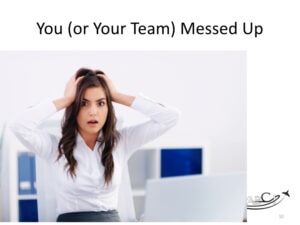 Paula Williams: Right. Okay. So that’s equipment, weather, other factors and so on. This is actually less … Everybody assumed this is the number one reason that people leave reviews because you or someone on your team messed up.
Paula Williams: Right. Okay. So that’s equipment, weather, other factors and so on. This is actually less … Everybody assumed this is the number one reason that people leave reviews because you or someone on your team messed up.
This is actually a lot less common than you would expect, but it also does happen. You’ve got people working with you, you’ve got yourself, heaven forbid, sooner or later somebody’s going to screw up. Right? If you’re working with human beings.
John Williams: Yeah, get the time zones mixed up.
Paula Williams: Yeah.
John Williams: Nobody I know does that.
Paula Williams: Oh my gosh. I’ve had situations with clients where I just could not schedule a meeting to save my life. Some days are just … Anyway, I now have a checklist for that to make sure that we get it right.
And I’ve got clocks everywhere in my office with different time zones and things and I write things down in my planner instead of just depending on the software to translate at times for me. So it does happen. People screw things up.
It Happens!
John Williams: Oh, you wouldn’t kid me?
Paula Williams: Well, not like you’ve ever screwed up.
John Williams: Yeah. But I’ve screwed up so much I don’t think there’s any more mistakes to make.
Paula Williams: Exactly. But what we don’t want to do is throw our team member under the bus, right? So if someone on our team screws up, that’s on me. I am the public face of the company and if something got messed up, I’m the one that makes sure that it gets fixed.
I’m the one who apologizes to the customer. I’m the one that does all that because the buck stops with me. So nobody will ever hear who on our team screwed up unless it was me. In spite of what I just said about John, who has never screwed up in his life.
So if I’m the public face of the company, that is my job and that taking the heat is what I get paid for. So that is what I do and so what I need to do is say, “Yes, we made a mistake. Here’s what we’re going to do about it.”
Guarantees and “Saves”
And then that’s on me personally to make sure that that gets fixed and that customer ends up back on track and things come out. All right. Right?
John Williams: Of course.
Paula Williams: Of course. And we do whatever we have to do to make it right. Which doesn’t mean we’ll never get bad online reviews, but we’re doing everything we can to prevent it.
John Williams: Yes we do.
Paula Williams: That’s why we have guarantees, that’s why we have basically everything that we’ve got. Almost always there is a way to turn a situation around and it’s just a matter of creativity and talking with a customer and saying, “Okay. So here’s what happened. This is not what we wanted, but here we are now. What do we do to make this right?”
And they will almost always have an idea-
John Williams: Yeah, most of them do.
Paula Williams: … of how they want that made right and how we want to work with them to do what we can to get them to the place they need to be and get them the results that they wanted.
John Williams: Yes, and we typically do.
Improving Your Odds By Getting More Reviews
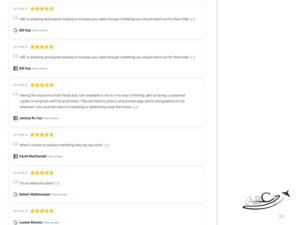 Paula Williams: Absolutely. Okay. So the more reviews you have, the more … The fewer reviews you have, the more biased the view is. The more reviews you have, the more protected you are when you get a bad one. So that’s kind of the best defense against any of those five things happening.
Paula Williams: Absolutely. Okay. So the more reviews you have, the more … The fewer reviews you have, the more biased the view is. The more reviews you have, the more protected you are when you get a bad one. So that’s kind of the best defense against any of those five things happening.
John Williams: Just remember the old GPA, the first two grades make it really tough on you.
Paula Williams: Yeah.
John Williams: Five years later, four years later, you get a C instead of an A, that’s not so bad.
Paula Williams: Right. So if you can front load all of those review sites with good reviews or at least the really important review sites with good reviews, then that will really help your average and it will make it so that each review is not as impactful as it would otherwise have been.
Our Three Part Reputation Management Series
So if you missed last week’s podcast that was talking about why managing your online reviews is important … And we talk about some cases of how that really impacts the success or failure of businesses and things like that. This week we’re talking about the five types of bad reviews and how to respond.
And then next week we’re going to talk about how to improve your odds and some things that you can do to make that happen.
John Williams: Never tell me the odds.
Paula Williams: In this case, we want to tell you the odds because this is all about odds, right?
John Williams: Uh-huh (affirmative).
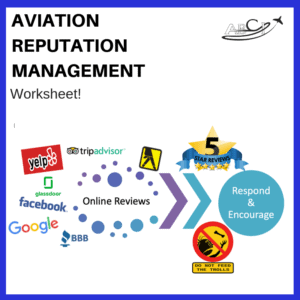 Paula Williams: Okay. So download our reputation management worksheet. It includes our triage process, those five common bad review types and how to respond, and suggested responses to common problems with some wording that you can adapt to your situation and make it work in a way that is kind, and responsive, and fast, and all of those things.
Paula Williams: Okay. So download our reputation management worksheet. It includes our triage process, those five common bad review types and how to respond, and suggested responses to common problems with some wording that you can adapt to your situation and make it work in a way that is kind, and responsive, and fast, and all of those things.
Because you don’t want to spend days refining your response while people fume. You want to make sure that you’re quick and ready for those kinds of things.
So if you have this worksheet you’re set, right?
John Williams: Yep.
ABCI’s Reputation Management Service
Paula Williams: Okay. If you would like us to manage your reviews for you, we now have a product for that and it is partly software and partly us working with you to define how you want these things handled. Setting up some common situations that could occur, brainstorming some of the things that could happen, and being ready for those kinds of things.
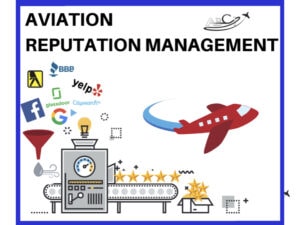 And then the software monitors all of the review sites, lets us know what’s going on, and lets us manage those in a way that gets you more reviews. Put some widgets on your website, send some emails, does some things to make sure that you get more reviews and that they are more likely to be good ones.
And then the software monitors all of the review sites, lets us know what’s going on, and lets us manage those in a way that gets you more reviews. Put some widgets on your website, send some emails, does some things to make sure that you get more reviews and that they are more likely to be good ones.
And in the week that we’ve been using this software, we’ve been getting a lot of reviews on our site. So we know for sure that the software works. We smoke test everything on ourselves, right?
John Williams: Yes. Before we ever release it.
Paula Williams: Yeah. So if you’re on our list, it is very likely that you’ve gotten an email from this software and hopefully you’ve responded to that. And if you have, thank you very much for doing that. It helped us really kind of work out the bugs of the system so that now we’re ready to roll that out for other people.
John Williams: Yes.
Paula Williams: Okay. So thank you for joining us and we will see you next week.
John Williams: Have a great day. See you next time.
Podcast: Play in new window | Download
Subscribe: Google Podcasts | Spotify | Amazon Music | RSS






On the off chance that it is a contender leaving a terrible survey and you can show that. So those are a few things that you can do to ensure that those get evacuated.
What you can’t get evacuated is on the off chance that it is straightforward and on the off chance that it is perhaps an innocent error. Someone had a terrible encounter, whatever, you can’t get it evacuated. Google, Facebook, those destinations have a ton put resources into validity and they’re getting assaulted a great deal on theirOn the off chance that it is a contender leaving a terrible survey and you can show that. So those are a few things that you can do to ensure that those get evacuated.
What you can’t get evacuated is on the off chance that it is straightforward and on the off chance that it is perhaps an innocent error. Someone had a terrible encounter, whatever, you can’t get it evacuated. Google, Facebook, those destinations have a ton put resources into validity and they’re getting assaulted a great deal on their believability.
“I’ve been looking for a post like this! I hate when I upload a photo and it doesn’t turn out looking the way I want it to. Thanks for sharing these tips! 🙂 Buy google voice number
“
“I really like your blog presentation. It is informative too, at the same time. This has helped in clarifying some of my doubts . Thanks a lot for your guidance! Can you read this Buy google voice number.
“
I have been looking for a publication like this! I hate when I upload a photo and it doesn’t look the way I want. Thanks for sharing these tips! https://accbay.com/product/buy-google-voice-number-account/
Useful informatics. To make your shopping exciting, check out this online shop
Hi Author,
The content of this website is really helpful in my marketing. It helps me a lot in understand what not and what needs to be done for a website to be more known. Thank you.
I do believe this is an excellent website. I stumbledupon it .I may revisit yet again since I book marked it.
Hello Author,
The content is your website is very reasonable and helpful.Thanks for sharing.
Great site ,i love reading your blogs .this content is very helpful for me. thanks for sharing.